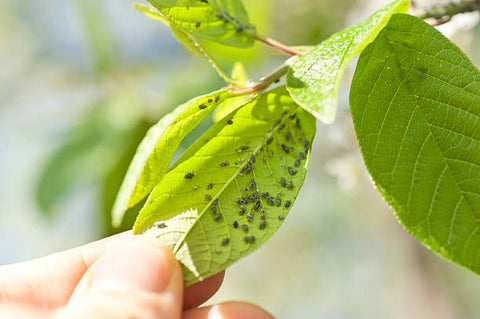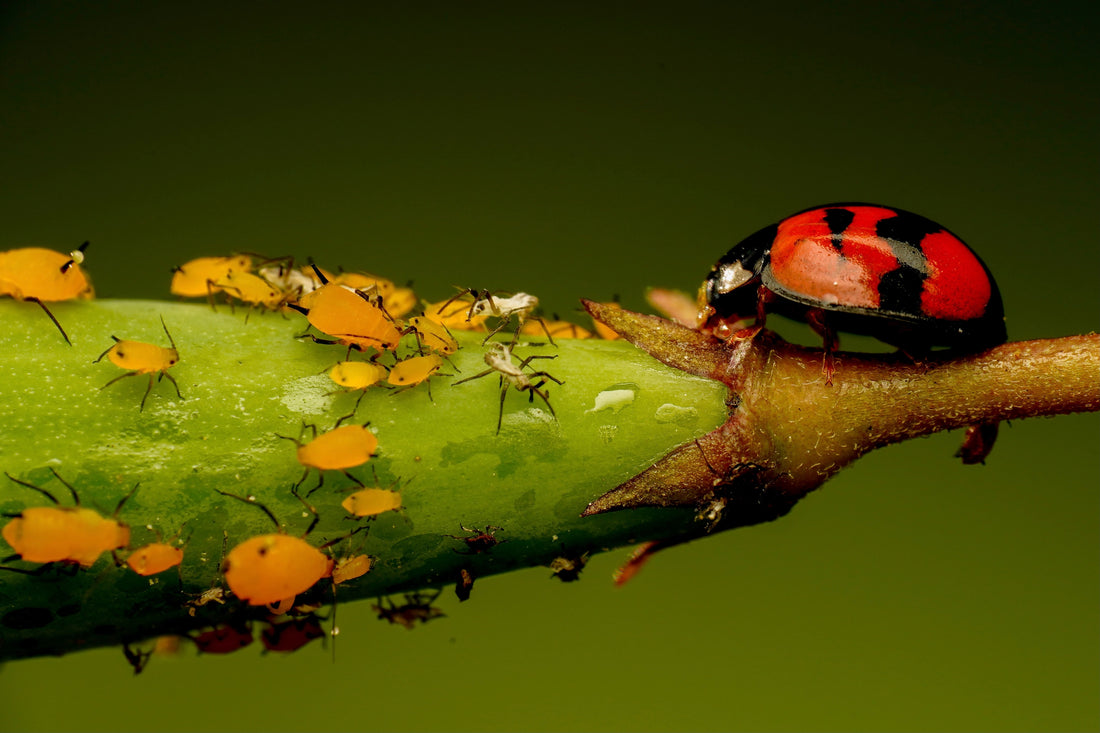Fall is right around the corner, which means goodbye to the sunny weather and for most of us, hello again to our houseplants! After spending the summer outdoors where they’ve been soaking up the sunlight and warm air, it’s about time to invite them back inside.

Typical to most plant parents, we are taught that the main points of concern when caring for our plant children consist of ensuring that they get proper sunlight, water and the nutrients in order to grow. But what is not talked about enough is that as any plant collection grows, so does the likelihood of encountering pests. And what better way to kick-off the “Spooky Season” than talking about these creepy-crawlies and how to handle them?

There are a lot of different household plant pests that can feed on your plants or cause infestations. Learning any information that you can on what to look for, how to prevent them and how to manage them will help you greatly if you ever encounter an infestation.
Prevention
The best way to manage household pests is by taking measures to prevent them. This way you can end the problem before it even starts. Preventative measures to avoid pest infiltrations in your plants include:
“Detoxing” plants that have been outside
Oftentimes during the summer season we take our houseplants on a little vacation to the outdoors because the warm conditions pose little risk and great benefits to their growth and happiness. But when it comes time to take the plants back inside, you always want to make sure that no pests are hitch-hiking a ride indoors along with them!

To avoid this, you will want to spray the whole plant down from top to bottom with a sharp stream of water from a hose. Usually this will be all it takes to dislodge any pests from your plants before bringing them back inside.
Inspecting and Quarantining New Plants
One of the easiest ways that pests can sneak into your home without you realizing is by catching a ride on a new plant from the nursery where it was grown. Before you introduce a new plant into your home and to your other plants, it’s always a good idea to examine the plant in its entirety. This means checking underneath the leaves, along the stems and even in the soil for any insects!

It may look to the naked eye that a new plant is free of pests, but it’s always possible that the plant has pest eggs or younger pests that aren’t visible to you yet. You can never be too safe by isolating a new plant in a room for a couple weeks. Check it every few days for signs of pests, and don’t put it in close proximity to your other plants until you’re sure it isn’t a breeding ground for any pesky bugs. This could save you from catastrophe in the long run.
Regularly Monitoring Your Plants
Inspecting your plants weekly for any signs of pests or damage will go a long way. If you can catch infiltration in its early stages before irreversible damage takes place and harmful bug populations multiply, you may be able to save you and your plants a lot of heartbreak. You’ll want to keep an eye out for any holes, discoloration, sticky brown spots or webbing, misshapen and or droopy leaves and stems. These can all be signs of pests.

Making a routine of washing your plant’s leaves every few weeks can be a good way to remember to check in on them and discourage pest infestation. You can wipe them down with a cloth and lukewarm water, or gently spray them depending on the plant's size and sturdiness.
Common Houseplant Pests & How to Manage Them (Without Chemicals!)
When you notice and identify pests of any sort on one of your plants, your first step should always be to isolate the plant immediately. You’ll want to contain and manage the issue as quickly as you can so that the infestation doesn’t spread to any of your other plants!
There are so many different kinds of household plant pests out there that it can get a little overwhelming. Compiled below are some of the most common pests, followed by how to handle any run-ins with them.
Scale
Scales can sometimes be hard to identify, appearing as little bumps along stems and on the underside of leaves. They are usually covered in a hard shell-like exterior and can range in color from gray, black, brown and sometimes are fuzzy. They feed by sucking the sap out of plants.

Early scale infestations can be taken care of simply by scraping the bugs off with your fingernail. As scales mature, their outer exterior can become a bit more hardened and waxy, and it is sometimes easiest to cover them in insecticidal soap.
Aphids
Small, plump and shaped like a pear, aphids can appear green, black, brown, red or yellow. They are usually found clumped together sucking sap from the underside or net growth of leaves. Aphids can cause yellowing leaves and deformed plant growth. These pests also excrete a sticky and shiny material known as honeydew that can lead to unsightly dark splotches on leaves.

Smaller aphid infestations are typically easily sprayed away with water or wiped away with a plant-friendly cloth soaked in water. This may have to be repeated multiple times to completely eliminate the problem, and sometimes it’s necessary to use insecticidal soap. Make sure to apply the soap directly to the insects.
Whiteflies
Resembling tiny moths, whiteflies are extremely small and a powdery-white color. They, like aphids, suck the sap from plants resulting in dying leaves and stunted growth. Whiteflies also reproduce rapidly and excrete honeydew.

Whiteflies can be trapped using yellow sticky cards, or you can apply insecticidal soap directly to them while ensuring you’re covering both upper and lower surfaces of the leaf.
Fungus Gnats
Not completely detrimental to the health of a plant, fungus gnats are seen as more of a nuisance to plant owners and a disruptor to the aesthetic appeal of having plants indoors. You’ll know you have fungus gnats when you disturb a plant and a small cloud of flies erupts from the surface of the plant’s soil.

Fungus gnat adult. Johnny N. Dell, Retired. www.insectimages.org
Dry conditions will kill fungus gnat larvae. This points to a simple reduction in watering and letting the plant’s soil dry out so that they do not continue to reproduce.

If only a specific portion of your plant is infested with pests, it may be in your and the plants best interest to simply remove and destroy that section. If the infestation lies in the roots of a plant, you also may want to consider taking a cutting and starting a new plant.
Early infestations of most types can often be removed by handpicking pests off the plant. And with more common houseplant pests, like the ones we just discussed, issues can usually be controlled and resolved by cleaning the plant with water or insecticidal soap. But all of this does not necessarily mean that you need to panic the second you spot an insect on one of your plants.
There are many harmless insects that simply wish to enjoy the hospitality of your plants as much as you do. In fact, a very effective way of controlling plant pests is by using other insects.
Beneficial/Harmless Insects
The thought of encouraging bugs to reside on your plants or in your home might leave your skin crawling and you yearning to click out of this page altogether. Nevertheless, not all insects are damaging to your plants' health and can actually protect them from the pests that do cause damage.
Ladybugs
Ladybugs are wildly beneficial bugs known to consume aphids, whiteflies, scale, mealybugs and spider mites. Their bright and distinct color makes them easy to locate and keep tabs on as they get to work eliminating your bug problems.

People usually purchase them as adults in small containers and release or place them onto their plants’ problem areas. On the downside, ladybugs can sometimes get distracted by windows and need help finding their way back to the plant. But again, their color makes them easy to spot and they are harmless as long as you’re not a sap-sucking pest.

Green Lacewings
Green Lacewings are natural born predators to essentially every houseplant pest besides adult hard scale. They can be purchased at any stage of their life be it as eggs, juveniles or adults.

Juveniles are famous for their incredibly voracious appetites, making them excellent bug hunters. They don’t gain their flight ability until adulthood, which means juveniles are less likely to leave the plant and explore the rest of your household.

Think of this all-natural pest control method as inviting the insects to join your team! If you ever do find yourself in a face-off between a harmful pest trying to infest your plants, they're the backup that you’ll want on your side. And on top of it all, you won’t have to worry about using chemicals to control the pests, which would get on your plant and soak into your soil.
Beneficial insects such as the two discussed above have long been contributors to large scale agriculture. Farmers may use insects in their practices because they eat pestiferous species, they can be pollinators and they help break down plant waste so it can be recycled into the soil. A lack of beneficial insects to any farm can leave crops vulnerable to the insects that will destroy them, which is why it is common to include them in agricultural practices. So don’t be too quick to rule them out of your own plant and gardening practices!
Sources:
https://anaturalcuriosity.org/beneficial-insects-how-to-control-houseplant-pests-using-good-bugs/
https://savvygardening.com/types-of-houseplant-bugs/
https://hgic.clemson.edu/factsheet/common-houseplant-insects-related-pests/

